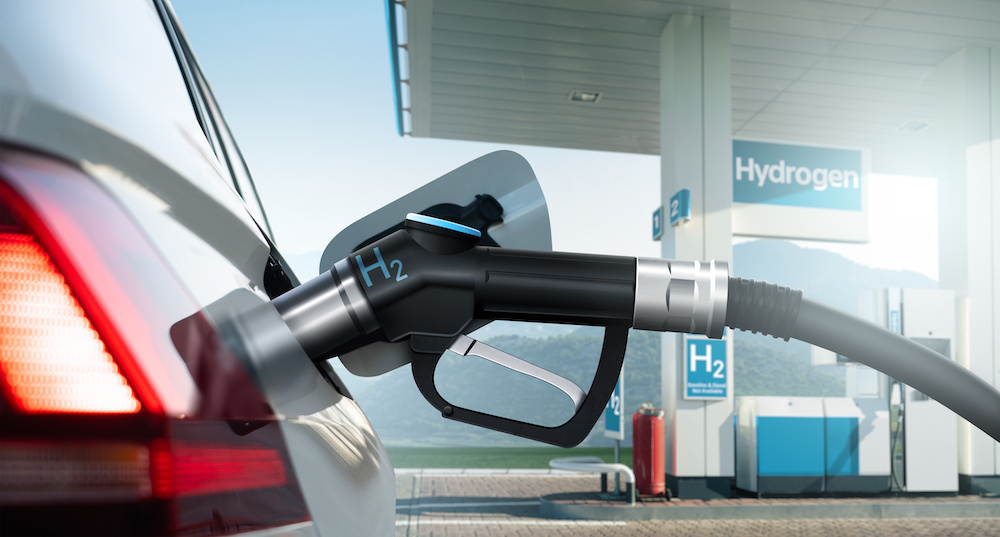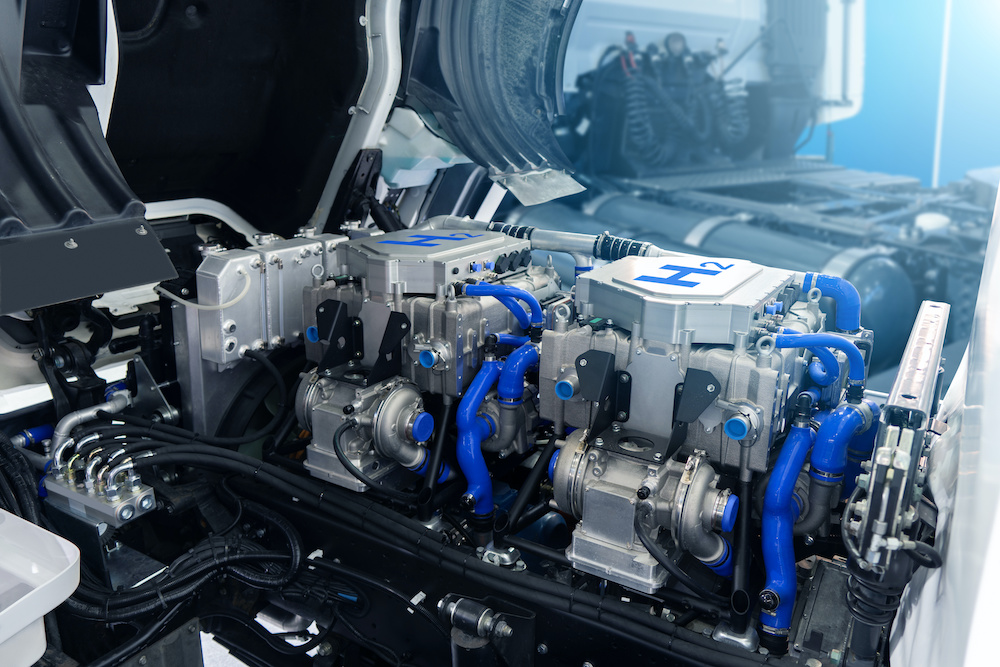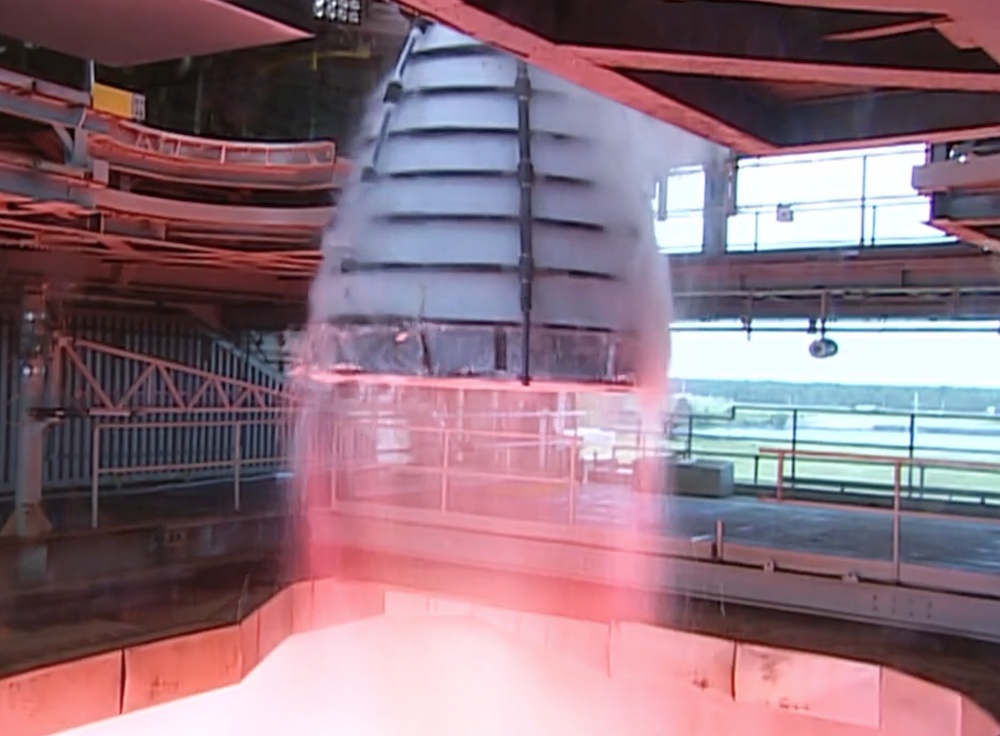
Hydrogen
Overcome Hydrogen Technology Design Challenges
As countries around the globe ramp up decarbonization efforts, hydrogen has emerged as a promising alternative fuel for transportation and power generation. If the hydrogen is generated using renewable energy sources, hydrogen-powered devices have the potential to be carbon-free during their operational lifetime. However, converting machines designed to run on conventional hydrocarbon fuels to run on hydrogen presents a number of challenges for engineers. Hydrogen is characterized by low density, high mass diffusivity, a wide flammability range, high burning velocities, and low ignition energy. All of these properties must be considered when designing hydrogen technology.
CONVERGE CFD software offers a wide range of features and modeling options that make it the ideal tool to address hydrogen design challenges. CONVERGE’s autonomous meshing simplifies case setup, even for complex geometries. Furthermore, CONVERGE includes a fast detailed chemistry solver and a library of state-of-the-art models for combustion, turbulence, conjugate heat transfer, and multi-phase flows, which maximize the efficiency and accuracy of the simulations.

CONVERGE’s Hydrogen Modeling Capabilities
Fast Case Setup, Even for Complex Geometries
No matter what technology you’re simulating, CONVERGE handles the meshing for you. Through its fully autonomous meshing, CONVERGE generates a high-quality Cartesian mesh at runtime using a novel cut-cell technique that maintains perfect resolution of your geometry at the level of its surface representation. And if your application includes moving boundaries, CONVERGE regenerates the mesh at each simulation time-step to accommodate the motion while maintaining the integrity of the mesh.
Efficiently Capture Hydrogen Dynamics
Because of hydrogen’s high injection and burning velocities, a finer mesh is required to capture the underlying physics. CONVERGE’s Adaptive Mesh Refinement (AMR) automatically adjusts the mesh throughout the simulation, adding cells in areas with dynamic physical phenomena and coarsening the mesh in other regions to achieve the most accurate distribution of grid refinement for your desired simulation runtime. AMR is particularly important in hydrogen simulations to capture high-speed gas jets, fuel-air mixing, shock waves, and fast-moving flame fronts.

Accurately Simulate Hydrogen & Multi-Fuel Combustion
CONVERGE’s SAGE detailed chemistry solver provides predictive combustion and emissions results for hydrogen and hydrogen blends. CONVERGE includes C3Mech, a detailed kinetic mechanism for surrogate fuels created and validated by the Computational Chemistry Consortium, for use with the SAGE solver. C3Mech contains chemistry for hydrogen and dozens of other commonly used fuel species. CONVERGE Studio, the graphical user interface for CONVERGE, features tools to extract the fuel chemistry of interest from C3Mech and create reduced skeletal mechanisms to facilitate shorter simulation runtimes. For dual fuel applications, C3Mech allows you to simulate hydrogen in combination with other fuels (e.g., ammonia or diesel) using chemistry derived from the same parent mechanism.
Because of hydrogen’s higher laminar flamespeed and smaller flame thickness, an impractically fine mesh is required to fully resolve flame propagation and fuel burning. CONVERGE includes a thickened flame model (TFM) that artificially thickens the flame, allowing for an accurate prediction of the combustion event at a reduced computational cost in LES simulations. CONVERGE also comes with a host of simplified combustion models, including G-Equation, ECFM, and the Eddy Dissipation Model, that can be used for hydrogen combustion modeling.
Hydrogen Applications

Internal Combustion Engines
Using hydrogen as a fuel for internal combustion engines (ICEs) provides a number of benefits beyond a reduction in carbon emissions. The faster flamespeeds and high octane number of hydrogen reduce the tendency of knock, allowing for a higher compression ratio and higher thermal efficiency. However, hydrogen reaches a higher combustion temperature than traditional hydrocarbon fuels, which can lead to hot spots on the combustion chamber walls and potentially cause undesirable autoignition and higher NOx emissions. Hydrogen ICEs are also susceptible to combustion instability under some operating conditions. In dual-fuel engines, hydrogen trapped in cylinder crevices can ignite during the valve overlap period, which can cause flame flashback into the fueled intake port.
Accurately simulating hydrogen injection is key to achieving reliable combustion and emissions predictions. CONVERGE is able to capture the high-speed direct injection of hydrogen and resolve the associated shock waves with its supersonic inflow capabilities, real gas equation of state models, and Adaptive Mesh Refinement. CONVERGE features simplified and detailed NOx models to predict engine-out NOx production, allowing engineers to virtually test NOx control strategies (e.g., lean burn, exhaust gas recirculation, water injection). In addition, CONVERGE contains a variety of tools for modeling NOx reduction via engine aftertreatment systems.
To mitigate flame flashback in an ICE, a flame arrestor can be placed in the intake manifold. A flame arrestor is composed of many narrow channels that absorb heat from the flame as it tries to travel through the device, lowering the temperature of flame enough to quench it. CONVERGE’s autonomous meshing makes it trivial to generate a mesh for the complex flame arrestor geometry. CONVERGE’s turbulence, combustion, and conjugate heat transfer modeling allow you to determine if the flame will be arrested and to study how the channel walls heat up over time after experiencing multiple flashback events.
Fuel Cells
Proton exchange membrane (PEM) fuel cells, also called polymer electrolyte membrane fuel cells, convert chemical energy from the reaction of hydrogen and oxygen into electrical energy. PEM fuel cells are attractive for transportation applications for a number of reasons: their only emissions are water and heat, they have relatively long lifetimes and low operational temperatures, and existing fueling infrastructure can be repurposed for hydrogen distribution.
CFD can help engineers improve the performance and efficiency of PEM fuel cells by predicting polarization curves and distributions of current density, temperature, and species concentration. CONVERGE’s multi-phase flow and conjugate heat transfer modeling allow you to monitor the water content of the fuel cell to avoid cathode flooding and membrane dry out. To model the fuel cell catalyst layer, CONVERGE features the ultra-thin layer model. This computationally efficient model assumes the electrochemical reactions occur at the interface between the membrane and the catalyst. In addition, CONVERGE’s automatic grid generation with inlaid meshing capabilities can effectively capture the complexity of modern fuel cell geometries.

Gas Turbines
Hydrogen-powered gas turbines could help the propulsion and power generation industries become more sustainable. Developing new gas turbine engines or modifying existing ones to run on hydrogen requires careful consideration of a variety of factors, and CONVERGE is well equipped to help.
While some gas turbines may be designed to run entirely on hydrogen, especially in the near-term many gas turbine engines will run a mixture of hydrogen and a hydrocarbon fuel (e.g., natural gas). Engineers must determine what blends of the two fuels and what operating conditions offer the best performance while maintaining emissions compliance and avoiding damage to the machine from the hotter-burning hydrogen. CONVERGE’s detailed chemistry solver can accommodate any variation in fuel blends given an accurate fuel chemistry mechanism. In addition, CONVERGE features a variety of emissions modeling options and a robust conjugate heat transfer model to investigate temperature distributions in the solid components.
Another primary concern for gas turbine designers is preventing flame flashback, a phenomenon in which the flame moves back toward the fuel injectors, potentially causing severe damage to the hardware. Predicting flame flashback is challenging because of the complex interplay between the unsteady fluid dynamics and the chemical kinetics. CONVERGE has the tools you need to overcome this challenge. With LES turbulence modeling, finite rate detailed chemistry, and Adaptive Mesh Refinement, CONVERGE can accurately predict the flashback limit and the subsequent upstream propagation of the flame.
Assessing lean blow-off limits (LBO) for hydrogen and hydrogen blends is another important aspect of gas turbine design. Lean combustion approaches can help gas turbine designers meet stringent emissions regulations, but these approaches can cause flame instability and LBO. CONVERGE’s LES turbulence modeling and fast detailed chemistry solver can capture the complex flow fields and chemical kinetic processes necessary to accurately predict LBO limits for hydrogen and hydrogen blends.
Rotating Detonation Engines
Rotating detonation engines (RDEs) are an advanced engine concept for propulsion and power generation applications. Compared to conventional gas turbines, RDEs have the potential to achieve higher efficiencies, lower emissions, and greater thrust. When designing a hydrogen-powered RDE, there are many complex phenomena that must be taken into account, including the structure and dynamics of the detonation waves, wall heat transfer, combustion stability, and emissions.
CONVERGE’s autonomous meshing, detailed chemistry, and state-of-the-art turbulence models allow you to study how different operating conditions and design parameters affect the combustion dynamics in an RDE. CONVERGE can accurately predict key RDE phenomena including wave frequency, wave height, and heat release. Additionally, CONVERGE’s Adaptive Mesh Refinement helps capture the high-speed hydrogen injection and the detonation wave front while keeping the overall cell count reasonable.
Rockets
Hydrogen is a common fuel for liquid rocket engines. The hydrogen onboard a rocket is typically stored under cryogenic conditions, which leads to a combination of subcritical and supercritical fluid dynamics during the mixing and combustion processes in both the pre-burner and the main combustion chamber. CONVERGE features the Real-Fluid Model (RFM), which incorporates the real gas mixing effects necessary to accurately model subcritical and supercritical mixing. With RFM, the expensive evaluations for density, thermodynamic, and transport properties are replaced with table lookups, increasing the simulation efficiency.

In addition, CONVERGE’s detailed chemistry solver and turbulence modeling enable you to study the combustion and heat release processes in the pre-burner and the main combustion chamber. With CONVERGE’s conjugate heat transfer modeling, you can analyze the temperature distributions in the solid components and design appropriate cooling systems. To help reduce the computational expense of the simulation, you can take advantage of CONVERGE’s 2D axisymmetric solver to simplify the 3D geometry of the combustion chamber or the fuel injector to a 2D planar geometry.
Safety & Storage
As hydrogen use expands, there’s an increased need for safe and effective hydrogen storage and transport methods. Storage units must be designed to handle the high volatility and flammability of hydrogen and to reduce the risk of ignition during a leak. CFD is an efficient and economical method for designing hydrogen storage systems and optimizing the tank filling and emptying processes.
CONVERGE contains a variety of modeling options for investigating the filling and emptying processes for hydrogen storage tanks: liquid and gas properties at cryogenic and high pressure conditions, volume of fluid modeling for multi-phase flows in liquid tanks, a boiling model to capture vaporization of cryogenic hydrogen, and conjugate heat transfer modeling to evaluate temperature distribution in the tank walls.
Under certain conditions, hydrogen stored under high pressure can self-ignite when exposed to ambient air, as in the case of a storage container leak. Self-ignition occurs due to friction, shock compression, and viscous heating as the hydrogen gas propagates through a small leakage channel. With CONVERGE’s inlaid meshing, you can achieve fine near-wall mesh resolution, which allows you to capture viscous heating at the walls and predict hydrogen-air mixing in the boundary layer. CONVERGE’s detailed chemistry solver and LES turbulence modeling enable you to accurately capture the process of self-ignition.
Should hydrogen ignition occur, it’s important to understand the conditions that lead to deflagration to detonation transitions (DDT), which can be highly destructive due to increased thermal and pressure loadings. CONVERGE offers a variety of tools to simulate the transition, including detailed chemistry, simplified combustion models, and a broad selection of turbulence models. The thickened flame model and Adaptive Mesh Refinement help to capture the flame front and the shock waves for more accurate simulations at reduced computational cost.
Kucuk, M., Sener, R., and Surmen, A., “Effectiveness of Hydrogen Enrichment Strategy for Wankel Engines in Unmanned Aerial Vehicle Applications at Various Altitudes,” International Journal of Hydrogen Energy, 54, Part B, 1534-1549, 2024. DOI: 10.1016/j.ijhydene.2023.08.304 Università di Modena e Reggio Emilia
Volza, A., Scrignoli, F., Caprioli, S., Mattarelli, E., and Rinaldini, C.A., “Exploring the Potential of Hydrogen Opposed Piston Engines for Single-Cylinder Electric Generators: A Computational Study,” SAE Paper 2023-24-0128, 2023. DOI: 10.4271/2023-24-0128 FEV Europe GmbH
Koerfer, T., “Efficiency-Biased Design of an H2-Fueled Internal Combustion Engine for Heavy and Challenging Applications,” SAE Paper 2023-24-0075, 2023. DOI: 10.4271/2023-24-0075 King Abdullah University of Science and Technology
Cabezas, K.M., Vorraro, G., Liu, X., Menaca, R., Im, H.G., and Turner, J.W.G., “Numerical Analysis of Hydrogen Injection and Mixing in Wankel Rotary Engines,” SAE Paper 2023-24-0069, 2023. DOI: 10.4271/2023-24-0069 Universitat Politècnica de València; Convergent Science
Gomez-Soriano, J., Sapkota, P., Wijeyakulasuriya, S., D’Elia, M., Probst, D., Viswanathan, V., Olcina-Girona, M., and Novella, R., “Numerical Modeling of Hydrogen Combustion Using Preferential Species Diffusion, Detailed Chemistry and Adaptive Mesh Refinement in Internal Combustion Engines,” SAE Paper 2023-24-0062, 2023. DOI: 10.4271/2023-24-0062 Ferrari S.p.A.; Convergent Science
Mortellaro, F.S., Silvestri, N., Zaffino, F., Medda, M., D’Elia, M., Viswanathan, V., and Rothbauer, R., “Effect of Start of Injection in a Hydrogen-Fueled DISI Engine: Experimental and Numerical Investigation,” SAE Paper 2023-24-0015, 2023. DOI: 10.4271/2023-24-0015 Toyota Motor Corporation
Tsukamoto, Y., Tanno, S., Miyamoto, Y., Sakai, H., Omura, T., and Takahashi, D., “Analysis of the Effect of Hydrogen Combustion Characteristics on Engine Performance,” SAE Paper 2023-32-0039/JSAE 20239062, 2023. Université d’Orléans; BorgWarner
Ferreira, J.M., Tinchon, A., Coratella, C., Oung, R., Doradoux, L., and Foucher, F., “A Validation Methodology for the 3D-CFD Model of a Hydrogen Injector,” 23. Internationales Stuttgarter Symposium, 2023. DOI: 10.1007/978-3-658-42048-2_24 CMT-Motores Térmicos
Novella, R., Pastor, J., Gomez-Soriano, J., and Sánchez-Bayona, J., “Numerical Study on the Use of Ammonia/Hydrogen Fuel Blends for Automotive Spark-Ignition Engines,” Fuel, 351, 2023. DOI: 10.1016/j.fuel.2023.128945 University of Cambridge
Gkantonas, S. and Mastorakos, E., “Low-Order Autoignition Modeling for Hydrogen Transverse Jets,” Journal of Propulsion and Power, 2023. DOI: 10.2514/1.B39142 Colorado State University
Castro, M.A.V., Kessler, I., and Windom, B.C., “Development of Natural Gas/Hydrogen Fuel Flexible Reduced Chemical Mechanism for Modeling of a Low Emission Gas Turbines,” 13th U.S. National Combustion Meeting, College Station, TX, United States, Mar 19–22, 2023. Convergent Science
Cojocaru, M.G., Sufrà, L., and Scienza, P., “Numerical Investigation of Hydrogen Self-Ignition and Deflagration-to-Detonation Phenomena Using Automated Meshing Approach and Detailed Chemistry,” ECCOMAS Congress 2022, Oslo, Norway, Jun 5–9, 2022.
For more CONVERGE papers, please check out the bibliography (PDF).






